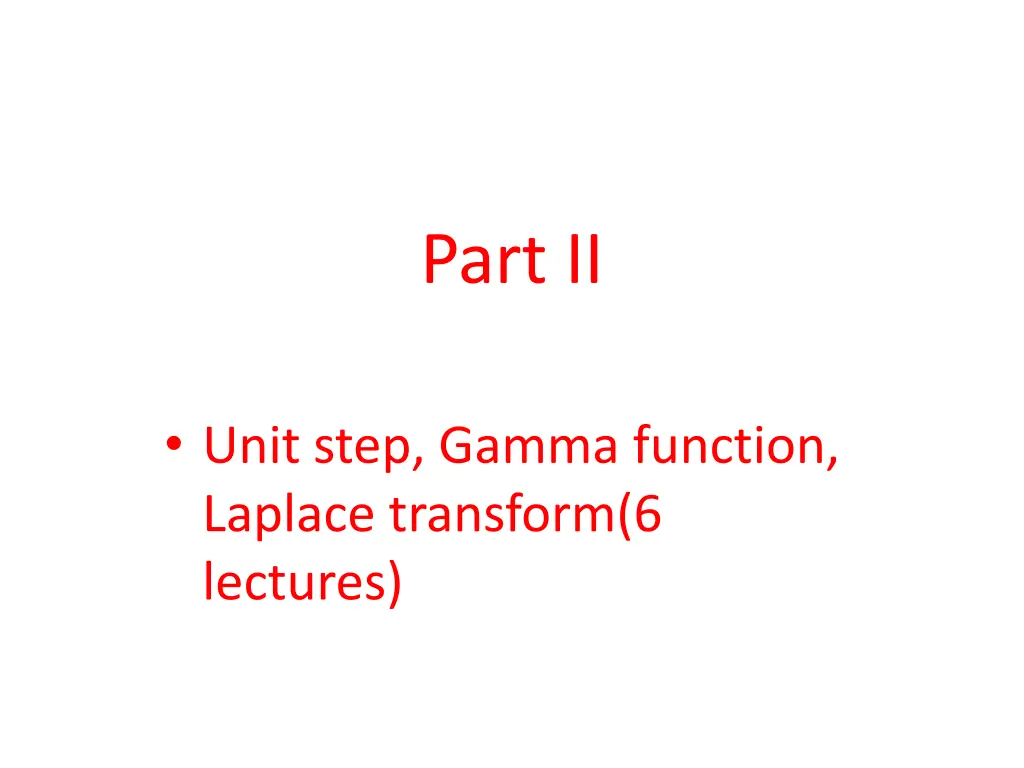
Understanding Unit Step Functions, Gamma Function, and Laplace Transform Concepts
Explore the fundamentals of unit step functions, gamma functions, and Laplace transforms through examples and properties. Learn how to express functions using unit step functions and compute Laplace transforms for various functions.
Download Presentation

Please find below an Image/Link to download the presentation.
The content on the website is provided AS IS for your information and personal use only. It may not be sold, licensed, or shared on other websites without obtaining consent from the author. If you encounter any issues during the download, it is possible that the publisher has removed the file from their server.
You are allowed to download the files provided on this website for personal or commercial use, subject to the condition that they are used lawfully. All files are the property of their respective owners.
The content on the website is provided AS IS for your information and personal use only. It may not be sold, licensed, or shared on other websites without obtaining consent from the author.
E N D
Presentation Transcript
Part II Unit step, Gamma function, Laplace transform(6 lectures)
Edited with the trial version of Foxit Advanced PDF Editor To remove this notice, visit: www.foxitsoftware.com/shopping Unit Step Function 1 The unit step function ua(t) can be 0 t a 1 t a 0 t 0 1 t 0 a defined as ua(t) = 1 u0(t) = Example Express the following functions in terms of the unit step function (a) f (t) = Solution (a) f (t) =8+ 2 t 2 (b) f (t) = K[ua(t) ub(t)] where ua(t) = 1 t a t a a t b t b 0 8 t 2 6 t 2 (b) f (t) = K 0 t 2 0 t 2 1 t 2 0 =8 2 =8 2u2(t) 0 t a 0 t b 1 t b ub(t) = and 2
Edited with the trial version of Foxit Advanced PDF Editor To remove this notice, visit: www.foxitsoftware.com/shopping Laplace Transform Let f (t) be a function of t. Then the Laplace Transform of f (t) is L f (t) = F(s) = f (t)e stdt 0 = 1 e e0 =1 s 1 L f (t) = L So, L k =k 1 = (1).e dt = es 0 Laplace Transform for some Functions f (t) =1 s st st 0 s f (t) = eat L eat = eat.e stdt = e (s a)tdt = L eat = s a cos(at), sin(at) 1 e (s a)t s a 0 0 0 1 1 (0 1) = s a ejat = cos(at)+ jsin(at) L ejat = L cos(at) + jL sin(at) L ejat = L ejat = s2 +a2 By comparison L cos(at) = 1 s+ ja=s+ ja s ja s+ ja + j s2 +a2 s s2 +a2a s a & L sin(at) = s2 +a2 s2 +a2 3
Edited with the trial version of Foxit Advanced PDF Editor To remove this notice, visit: www.foxitsoftware.com/shopping f (t) =sinh(at) =1( eat e at) L sinh(at) =1 2 1 s + a s + a = 1 1 a = 2 s a s + a 2 s2 a2 s2 a2 f (t) = cosh(at) =1( eat +e at) L cosh(at) =1 f (t) =t 2 1 s +a+ s a = 1 1 s + = 2 s a s +a 2 s2 a2 s2 a2 L t = t.e stdt 0 u =t v = 1e st du = dt , dv = e stdt s 1 s2 = 1( e e0) s2 1 0 st st + e dt = 0 0 s e L t = te st L t =1 0 0 s s2 n! In general, L tn = sn+1 f (t) =u(t) L u(t) f (t) = ua(t) 1 =1 = u(t)e dt = (1)e dt = 0 0 st st st e s 0 s 4
Edited with the trial version of Foxit Advanced PDF Editor To remove this notice, visit: www.foxitsoftware.com/shopping L u (t) = u (t)e stdt = (1)e stdt = 1e st a a 0 as =e a s s a Laplace Transform Properties 1) Linearity If F1(s) = L f1(t) and F2(s) = L f2(t) then L C1f1(t)+C2 f2(t) = C1F1(s)+C2F2(s) L 4t2 3cos(2t)+5e t = 4 2! 3 =8 1 s +5 s2 +4 5 s +1 s3 3s + Example s2 +4 s +1 s3 2) Shifting Property If F(s) = L f (t) then L eatf (t) = F(s a) If F(s) = L f (t) then Example L e tcos(2t) L f (t a) = F(s)e as s and s2 +4 Here, f (t) = cos(2t) & a = 1, then F(s) = 5
Edited with the trial version of Foxit Advanced PDF Editor To remove this notice, visit: www.foxitsoftware.com/shopping s+1 L e tcos(2t) = F(s +1) = (s +1)2+4 3) Derivative Property If F(s) = L f (t) then L f (t) = sF(s) f (0) L f (t) = s2F(s) sf (0) f (0) F(s) t L f (u)du = 0 4) Integral Property If F(s) = L f (t) then L sin(2u)du Here, f (t) =sin(2t) then F(s) = s Example t 0 2 and t s2 +4 F(s)= 2 L sin(2u)du = 5) Multiplication by tn If F(s) = L f (t) then s(s2 +4) s 0 n L = ( 1) d F(s) n n t f (t) dsn 6
